Research Proposal: Pokhara Adventure Tourism and Nepal's Economy
VerifiedAdded on 2022/12/19
|9
|1849
|6
Report
AI Summary
This research proposal investigates the impact of Pokhara adventure tourism on Nepal's economy. The study explores the existing literature on adventure tourism, focusing on how Pokhara has become a significant contributor to Nepal's tourism sector. The research aims to analyze the key research question: How does Pokhara adventure tourism impact Nepal's economy? The proposal outlines the methodology, including secondary data sources from journals, articles, and government offices. The analysis will employ qualitative data analysis techniques, focusing on content development, structure creation, and functional analysis to examine the research problem. The timetable details the stages of the research, from topic selection to the submission of the final work. The references include a comprehensive list of sources, highlighting the evolution of adventure tourism, the impact of tourism on economic growth, and the significance of Pokhara as a key destination.
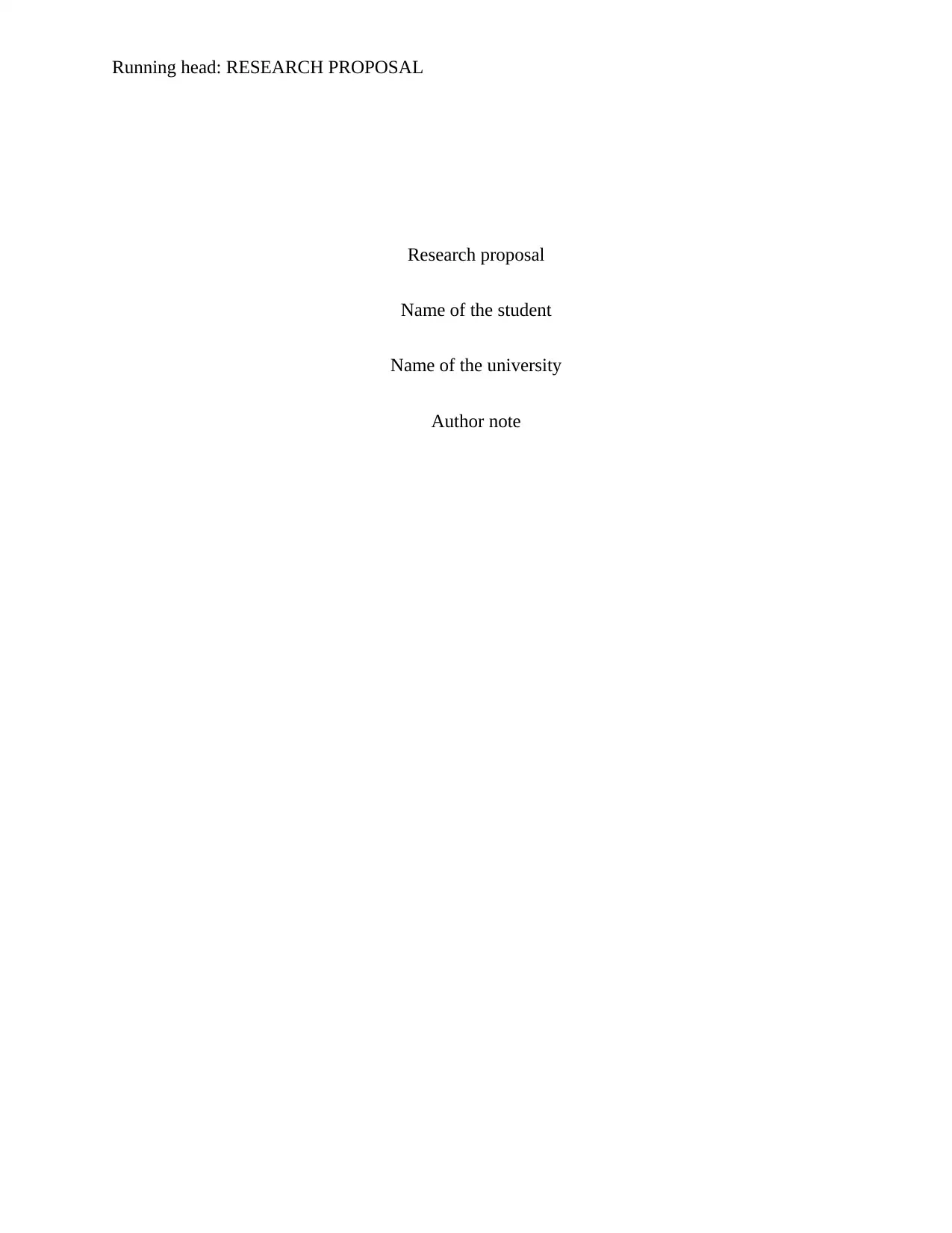
Running head: RESEARCH PROPOSAL
Research proposal
Name of the student
Name of the university
Author note
Research proposal
Name of the student
Name of the university
Author note
Paraphrase This Document
Need a fresh take? Get an instant paraphrase of this document with our AI Paraphraser
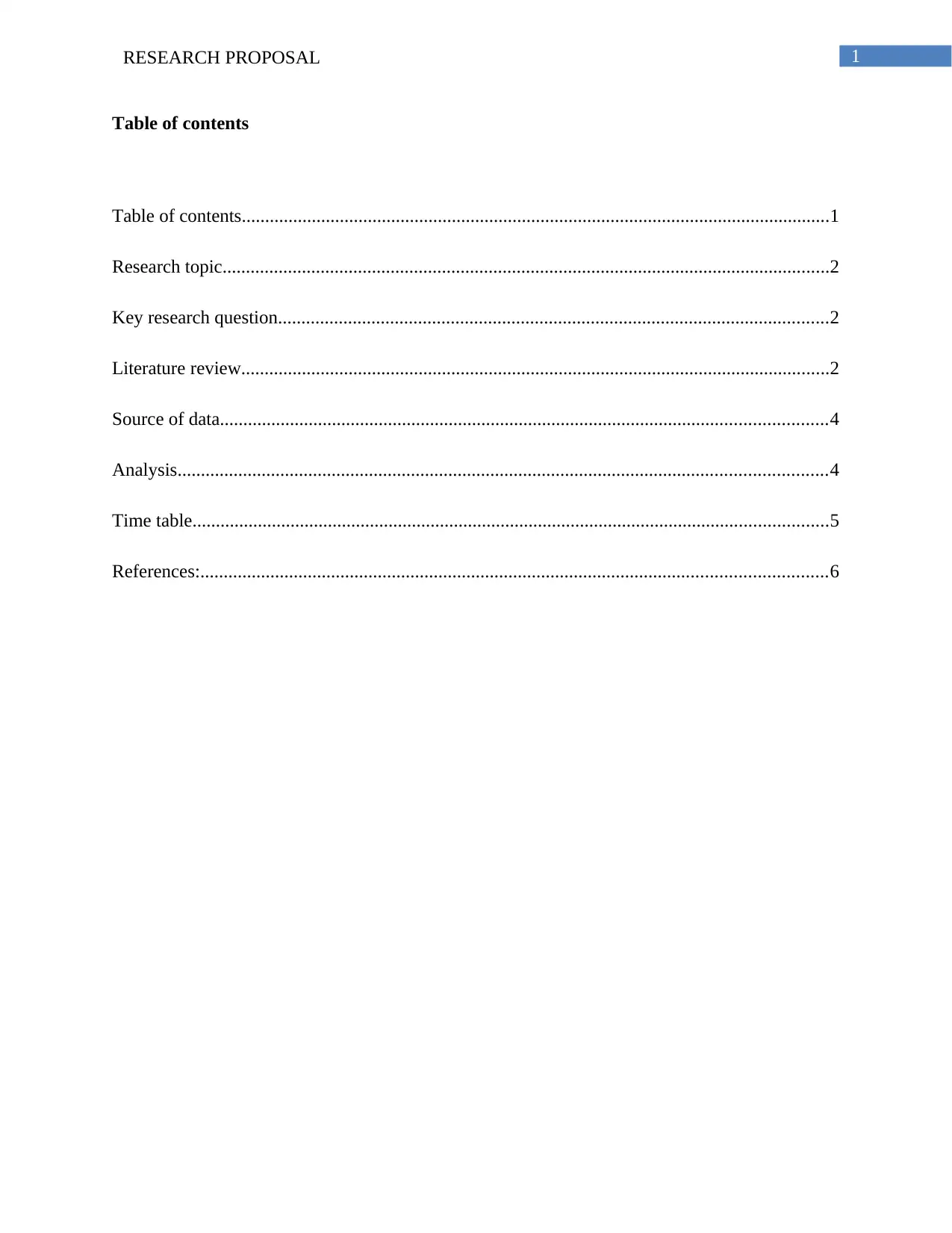
1RESEARCH PROPOSAL
Table of contents
Table of contents..............................................................................................................................1
Research topic..................................................................................................................................2
Key research question......................................................................................................................2
Literature review..............................................................................................................................2
Source of data..................................................................................................................................4
Analysis...........................................................................................................................................4
Time table........................................................................................................................................5
References:......................................................................................................................................6
Table of contents
Table of contents..............................................................................................................................1
Research topic..................................................................................................................................2
Key research question......................................................................................................................2
Literature review..............................................................................................................................2
Source of data..................................................................................................................................4
Analysis...........................................................................................................................................4
Time table........................................................................................................................................5
References:......................................................................................................................................6
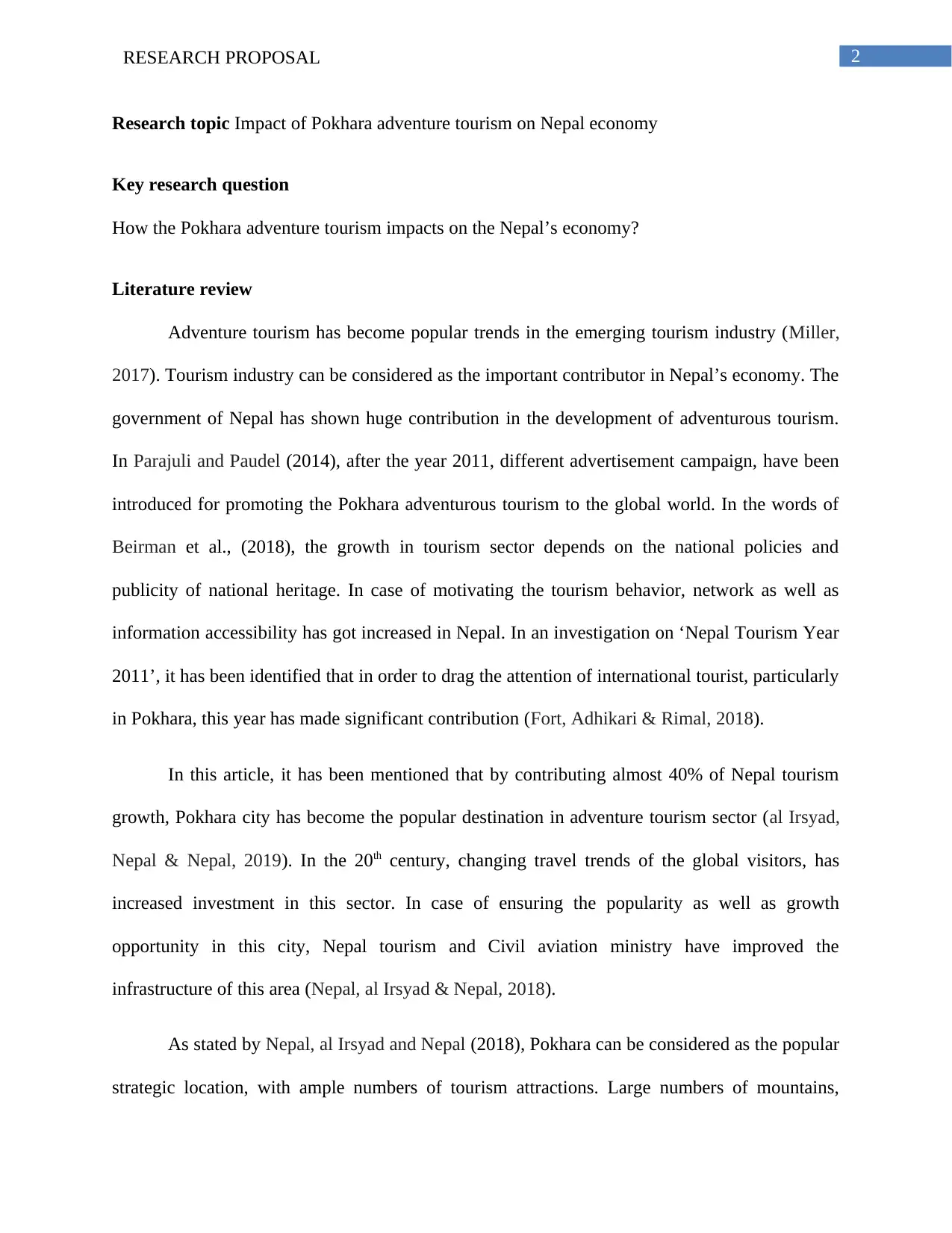
2RESEARCH PROPOSAL
Research topic Impact of Pokhara adventure tourism on Nepal economy
Key research question
How the Pokhara adventure tourism impacts on the Nepal’s economy?
Literature review
Adventure tourism has become popular trends in the emerging tourism industry (Miller,
2017). Tourism industry can be considered as the important contributor in Nepal’s economy. The
government of Nepal has shown huge contribution in the development of adventurous tourism.
In Parajuli and Paudel (2014), after the year 2011, different advertisement campaign, have been
introduced for promoting the Pokhara adventurous tourism to the global world. In the words of
Beirman et al., (2018), the growth in tourism sector depends on the national policies and
publicity of national heritage. In case of motivating the tourism behavior, network as well as
information accessibility has got increased in Nepal. In an investigation on ‘Nepal Tourism Year
2011’, it has been identified that in order to drag the attention of international tourist, particularly
in Pokhara, this year has made significant contribution (Fort, Adhikari & Rimal, 2018).
In this article, it has been mentioned that by contributing almost 40% of Nepal tourism
growth, Pokhara city has become the popular destination in adventure tourism sector (al Irsyad,
Nepal & Nepal, 2019). In the 20th century, changing travel trends of the global visitors, has
increased investment in this sector. In case of ensuring the popularity as well as growth
opportunity in this city, Nepal tourism and Civil aviation ministry have improved the
infrastructure of this area (Nepal, al Irsyad & Nepal, 2018).
As stated by Nepal, al Irsyad and Nepal (2018), Pokhara can be considered as the popular
strategic location, with ample numbers of tourism attractions. Large numbers of mountains,
Research topic Impact of Pokhara adventure tourism on Nepal economy
Key research question
How the Pokhara adventure tourism impacts on the Nepal’s economy?
Literature review
Adventure tourism has become popular trends in the emerging tourism industry (Miller,
2017). Tourism industry can be considered as the important contributor in Nepal’s economy. The
government of Nepal has shown huge contribution in the development of adventurous tourism.
In Parajuli and Paudel (2014), after the year 2011, different advertisement campaign, have been
introduced for promoting the Pokhara adventurous tourism to the global world. In the words of
Beirman et al., (2018), the growth in tourism sector depends on the national policies and
publicity of national heritage. In case of motivating the tourism behavior, network as well as
information accessibility has got increased in Nepal. In an investigation on ‘Nepal Tourism Year
2011’, it has been identified that in order to drag the attention of international tourist, particularly
in Pokhara, this year has made significant contribution (Fort, Adhikari & Rimal, 2018).
In this article, it has been mentioned that by contributing almost 40% of Nepal tourism
growth, Pokhara city has become the popular destination in adventure tourism sector (al Irsyad,
Nepal & Nepal, 2019). In the 20th century, changing travel trends of the global visitors, has
increased investment in this sector. In case of ensuring the popularity as well as growth
opportunity in this city, Nepal tourism and Civil aviation ministry have improved the
infrastructure of this area (Nepal, al Irsyad & Nepal, 2018).
As stated by Nepal, al Irsyad and Nepal (2018), Pokhara can be considered as the popular
strategic location, with ample numbers of tourism attractions. Large numbers of mountains,
⊘ This is a preview!⊘
Do you want full access?
Subscribe today to unlock all pages.

Trusted by 1+ million students worldwide
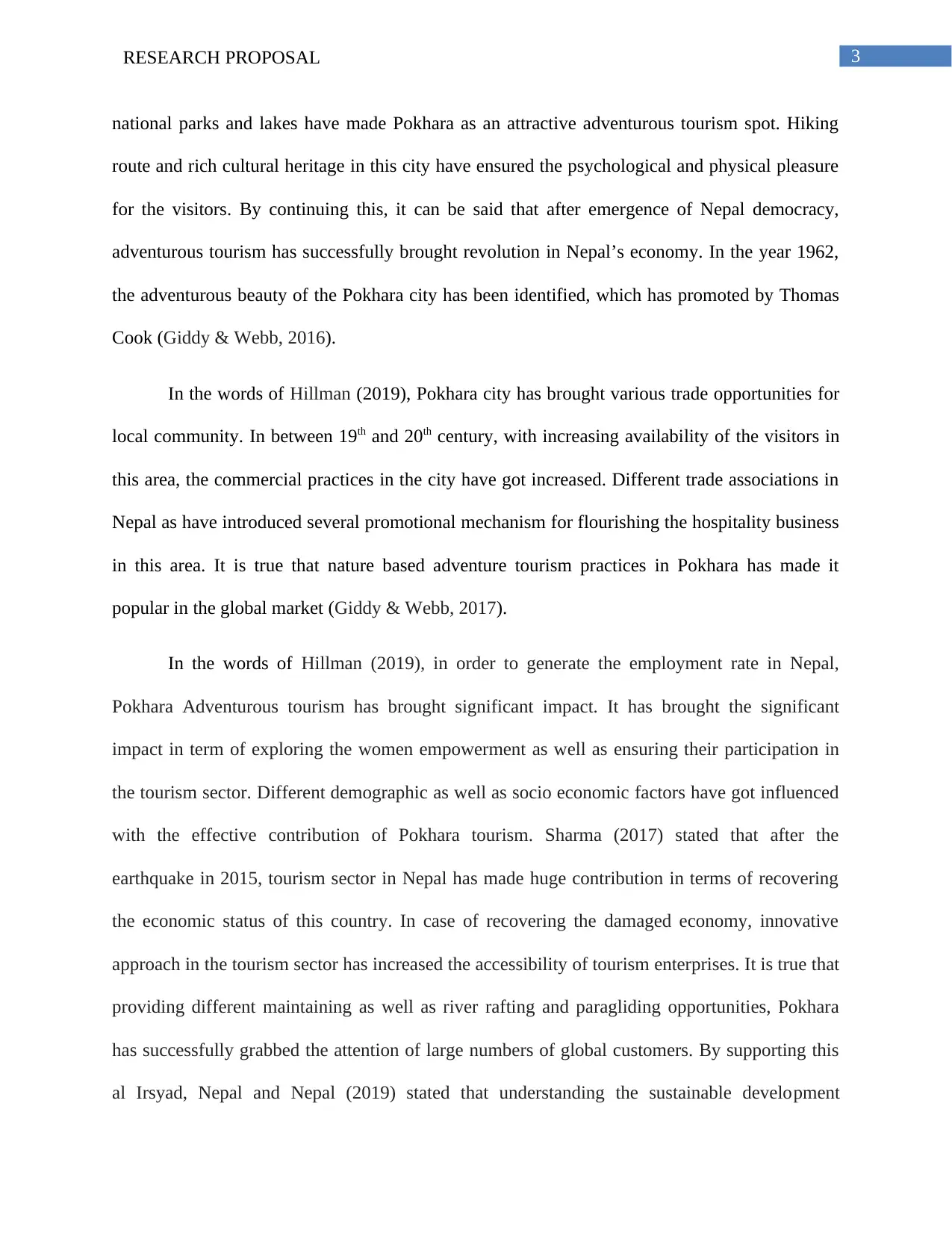
3RESEARCH PROPOSAL
national parks and lakes have made Pokhara as an attractive adventurous tourism spot. Hiking
route and rich cultural heritage in this city have ensured the psychological and physical pleasure
for the visitors. By continuing this, it can be said that after emergence of Nepal democracy,
adventurous tourism has successfully brought revolution in Nepal’s economy. In the year 1962,
the adventurous beauty of the Pokhara city has been identified, which has promoted by Thomas
Cook (Giddy & Webb, 2016).
In the words of Hillman (2019), Pokhara city has brought various trade opportunities for
local community. In between 19th and 20th century, with increasing availability of the visitors in
this area, the commercial practices in the city have got increased. Different trade associations in
Nepal as have introduced several promotional mechanism for flourishing the hospitality business
in this area. It is true that nature based adventure tourism practices in Pokhara has made it
popular in the global market (Giddy & Webb, 2017).
In the words of Hillman (2019), in order to generate the employment rate in Nepal,
Pokhara Adventurous tourism has brought significant impact. It has brought the significant
impact in term of exploring the women empowerment as well as ensuring their participation in
the tourism sector. Different demographic as well as socio economic factors have got influenced
with the effective contribution of Pokhara tourism. Sharma (2017) stated that after the
earthquake in 2015, tourism sector in Nepal has made huge contribution in terms of recovering
the economic status of this country. In case of recovering the damaged economy, innovative
approach in the tourism sector has increased the accessibility of tourism enterprises. It is true that
providing different maintaining as well as river rafting and paragliding opportunities, Pokhara
has successfully grabbed the attention of large numbers of global customers. By supporting this
al Irsyad, Nepal and Nepal (2019) stated that understanding the sustainable development
national parks and lakes have made Pokhara as an attractive adventurous tourism spot. Hiking
route and rich cultural heritage in this city have ensured the psychological and physical pleasure
for the visitors. By continuing this, it can be said that after emergence of Nepal democracy,
adventurous tourism has successfully brought revolution in Nepal’s economy. In the year 1962,
the adventurous beauty of the Pokhara city has been identified, which has promoted by Thomas
Cook (Giddy & Webb, 2016).
In the words of Hillman (2019), Pokhara city has brought various trade opportunities for
local community. In between 19th and 20th century, with increasing availability of the visitors in
this area, the commercial practices in the city have got increased. Different trade associations in
Nepal as have introduced several promotional mechanism for flourishing the hospitality business
in this area. It is true that nature based adventure tourism practices in Pokhara has made it
popular in the global market (Giddy & Webb, 2017).
In the words of Hillman (2019), in order to generate the employment rate in Nepal,
Pokhara Adventurous tourism has brought significant impact. It has brought the significant
impact in term of exploring the women empowerment as well as ensuring their participation in
the tourism sector. Different demographic as well as socio economic factors have got influenced
with the effective contribution of Pokhara tourism. Sharma (2017) stated that after the
earthquake in 2015, tourism sector in Nepal has made huge contribution in terms of recovering
the economic status of this country. In case of recovering the damaged economy, innovative
approach in the tourism sector has increased the accessibility of tourism enterprises. It is true that
providing different maintaining as well as river rafting and paragliding opportunities, Pokhara
has successfully grabbed the attention of large numbers of global customers. By supporting this
al Irsyad, Nepal and Nepal (2019) stated that understanding the sustainable development
Paraphrase This Document
Need a fresh take? Get an instant paraphrase of this document with our AI Paraphraser
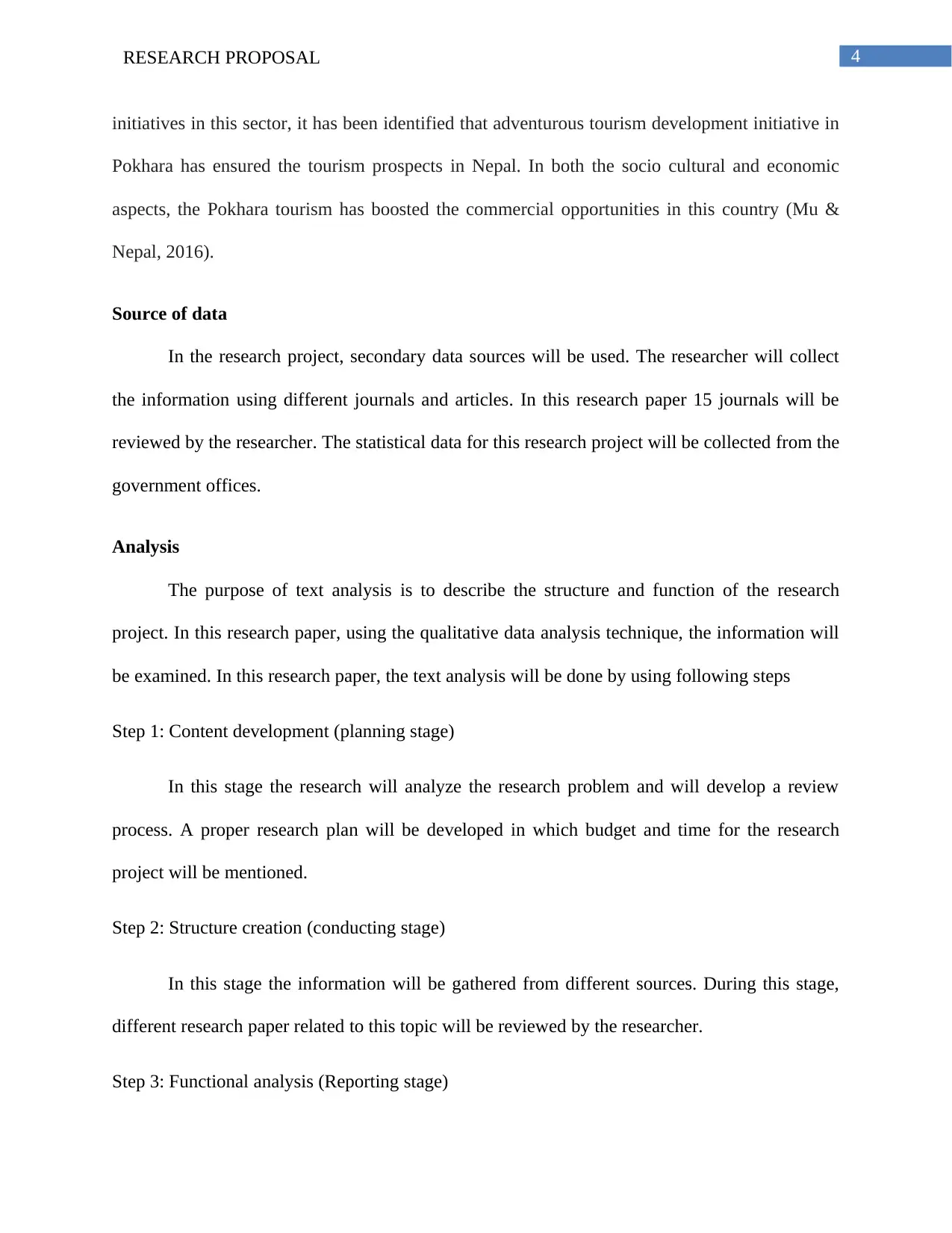
4RESEARCH PROPOSAL
initiatives in this sector, it has been identified that adventurous tourism development initiative in
Pokhara has ensured the tourism prospects in Nepal. In both the socio cultural and economic
aspects, the Pokhara tourism has boosted the commercial opportunities in this country (Mu &
Nepal, 2016).
Source of data
In the research project, secondary data sources will be used. The researcher will collect
the information using different journals and articles. In this research paper 15 journals will be
reviewed by the researcher. The statistical data for this research project will be collected from the
government offices.
Analysis
The purpose of text analysis is to describe the structure and function of the research
project. In this research paper, using the qualitative data analysis technique, the information will
be examined. In this research paper, the text analysis will be done by using following steps
Step 1: Content development (planning stage)
In this stage the research will analyze the research problem and will develop a review
process. A proper research plan will be developed in which budget and time for the research
project will be mentioned.
Step 2: Structure creation (conducting stage)
In this stage the information will be gathered from different sources. During this stage,
different research paper related to this topic will be reviewed by the researcher.
Step 3: Functional analysis (Reporting stage)
initiatives in this sector, it has been identified that adventurous tourism development initiative in
Pokhara has ensured the tourism prospects in Nepal. In both the socio cultural and economic
aspects, the Pokhara tourism has boosted the commercial opportunities in this country (Mu &
Nepal, 2016).
Source of data
In the research project, secondary data sources will be used. The researcher will collect
the information using different journals and articles. In this research paper 15 journals will be
reviewed by the researcher. The statistical data for this research project will be collected from the
government offices.
Analysis
The purpose of text analysis is to describe the structure and function of the research
project. In this research paper, using the qualitative data analysis technique, the information will
be examined. In this research paper, the text analysis will be done by using following steps
Step 1: Content development (planning stage)
In this stage the research will analyze the research problem and will develop a review
process. A proper research plan will be developed in which budget and time for the research
project will be mentioned.
Step 2: Structure creation (conducting stage)
In this stage the information will be gathered from different sources. During this stage,
different research paper related to this topic will be reviewed by the researcher.
Step 3: Functional analysis (Reporting stage)
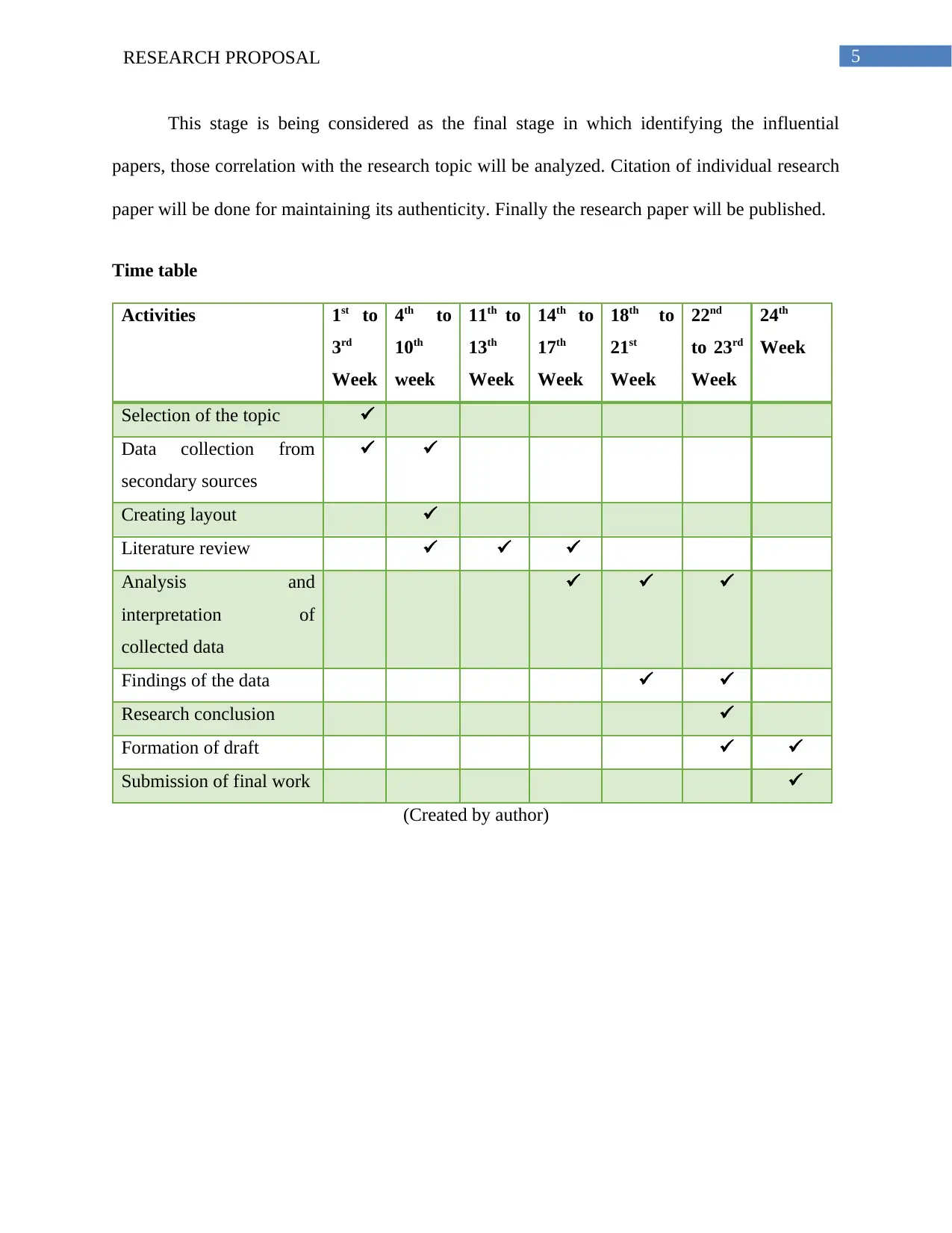
5RESEARCH PROPOSAL
This stage is being considered as the final stage in which identifying the influential
papers, those correlation with the research topic will be analyzed. Citation of individual research
paper will be done for maintaining its authenticity. Finally the research paper will be published.
Time table
Activities 1st to
3rd
Week
4th to
10th
week
11th to
13th
Week
14th to
17th
Week
18th to
21st
Week
22nd
to 23rd
Week
24th
Week
Selection of the topic
Data collection from
secondary sources
Creating layout
Literature review
Analysis and
interpretation of
collected data
Findings of the data
Research conclusion
Formation of draft
Submission of final work
(Created by author)
This stage is being considered as the final stage in which identifying the influential
papers, those correlation with the research topic will be analyzed. Citation of individual research
paper will be done for maintaining its authenticity. Finally the research paper will be published.
Time table
Activities 1st to
3rd
Week
4th to
10th
week
11th to
13th
Week
14th to
17th
Week
18th to
21st
Week
22nd
to 23rd
Week
24th
Week
Selection of the topic
Data collection from
secondary sources
Creating layout
Literature review
Analysis and
interpretation of
collected data
Findings of the data
Research conclusion
Formation of draft
Submission of final work
(Created by author)
⊘ This is a preview!⊘
Do you want full access?
Subscribe today to unlock all pages.

Trusted by 1+ million students worldwide
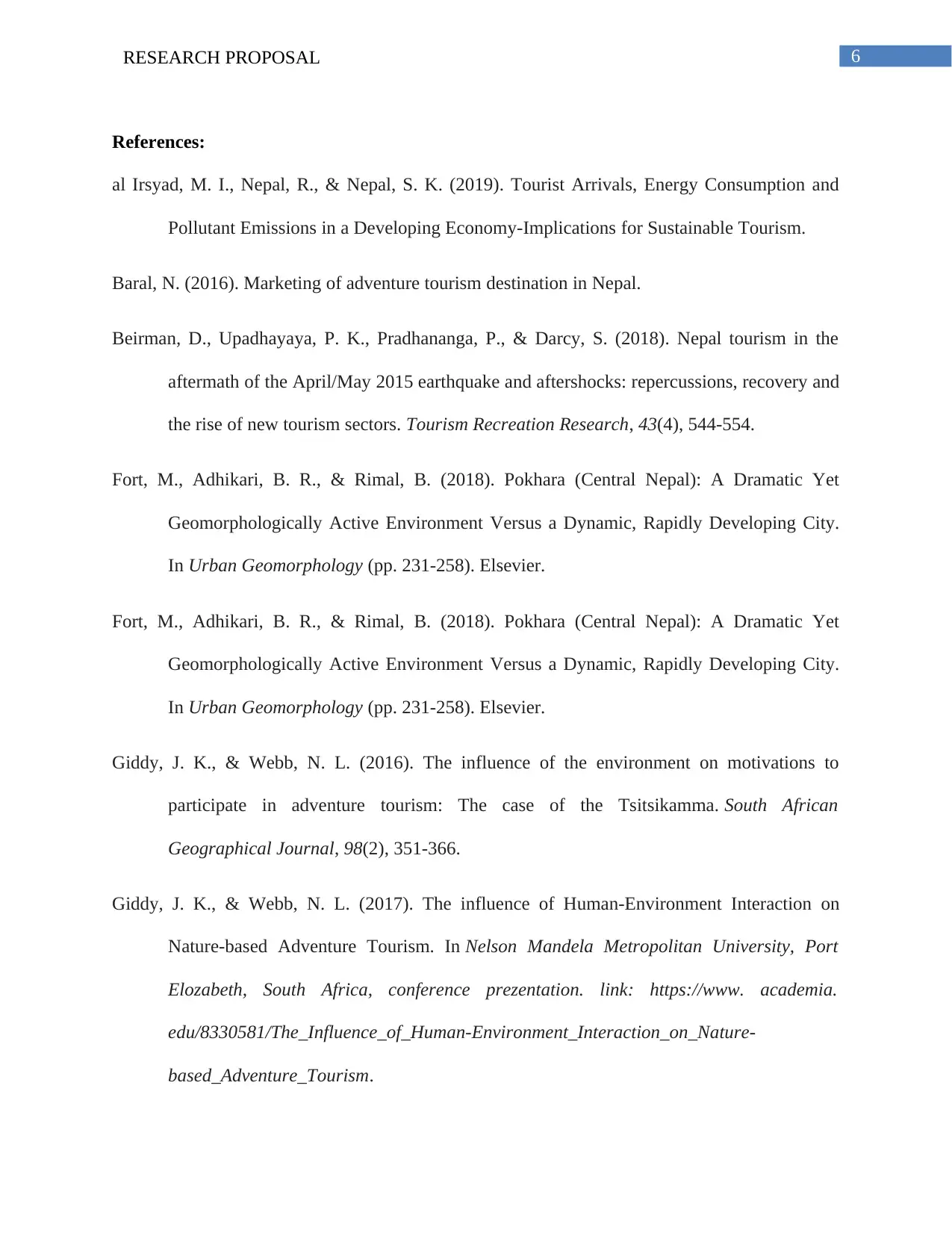
6RESEARCH PROPOSAL
References:
al Irsyad, M. I., Nepal, R., & Nepal, S. K. (2019). Tourist Arrivals, Energy Consumption and
Pollutant Emissions in a Developing Economy-Implications for Sustainable Tourism.
Baral, N. (2016). Marketing of adventure tourism destination in Nepal.
Beirman, D., Upadhayaya, P. K., Pradhananga, P., & Darcy, S. (2018). Nepal tourism in the
aftermath of the April/May 2015 earthquake and aftershocks: repercussions, recovery and
the rise of new tourism sectors. Tourism Recreation Research, 43(4), 544-554.
Fort, M., Adhikari, B. R., & Rimal, B. (2018). Pokhara (Central Nepal): A Dramatic Yet
Geomorphologically Active Environment Versus a Dynamic, Rapidly Developing City.
In Urban Geomorphology (pp. 231-258). Elsevier.
Fort, M., Adhikari, B. R., & Rimal, B. (2018). Pokhara (Central Nepal): A Dramatic Yet
Geomorphologically Active Environment Versus a Dynamic, Rapidly Developing City.
In Urban Geomorphology (pp. 231-258). Elsevier.
Giddy, J. K., & Webb, N. L. (2016). The influence of the environment on motivations to
participate in adventure tourism: The case of the Tsitsikamma. South African
Geographical Journal, 98(2), 351-366.
Giddy, J. K., & Webb, N. L. (2017). The influence of Human-Environment Interaction on
Nature-based Adventure Tourism. In Nelson Mandela Metropolitan University, Port
Elozabeth, South Africa, conference prezentation. link: https://www. academia.
edu/8330581/The_Influence_of_Human-Environment_Interaction_on_Nature-
based_Adventure_Tourism.
References:
al Irsyad, M. I., Nepal, R., & Nepal, S. K. (2019). Tourist Arrivals, Energy Consumption and
Pollutant Emissions in a Developing Economy-Implications for Sustainable Tourism.
Baral, N. (2016). Marketing of adventure tourism destination in Nepal.
Beirman, D., Upadhayaya, P. K., Pradhananga, P., & Darcy, S. (2018). Nepal tourism in the
aftermath of the April/May 2015 earthquake and aftershocks: repercussions, recovery and
the rise of new tourism sectors. Tourism Recreation Research, 43(4), 544-554.
Fort, M., Adhikari, B. R., & Rimal, B. (2018). Pokhara (Central Nepal): A Dramatic Yet
Geomorphologically Active Environment Versus a Dynamic, Rapidly Developing City.
In Urban Geomorphology (pp. 231-258). Elsevier.
Fort, M., Adhikari, B. R., & Rimal, B. (2018). Pokhara (Central Nepal): A Dramatic Yet
Geomorphologically Active Environment Versus a Dynamic, Rapidly Developing City.
In Urban Geomorphology (pp. 231-258). Elsevier.
Giddy, J. K., & Webb, N. L. (2016). The influence of the environment on motivations to
participate in adventure tourism: The case of the Tsitsikamma. South African
Geographical Journal, 98(2), 351-366.
Giddy, J. K., & Webb, N. L. (2017). The influence of Human-Environment Interaction on
Nature-based Adventure Tourism. In Nelson Mandela Metropolitan University, Port
Elozabeth, South Africa, conference prezentation. link: https://www. academia.
edu/8330581/The_Influence_of_Human-Environment_Interaction_on_Nature-
based_Adventure_Tourism.
Paraphrase This Document
Need a fresh take? Get an instant paraphrase of this document with our AI Paraphraser
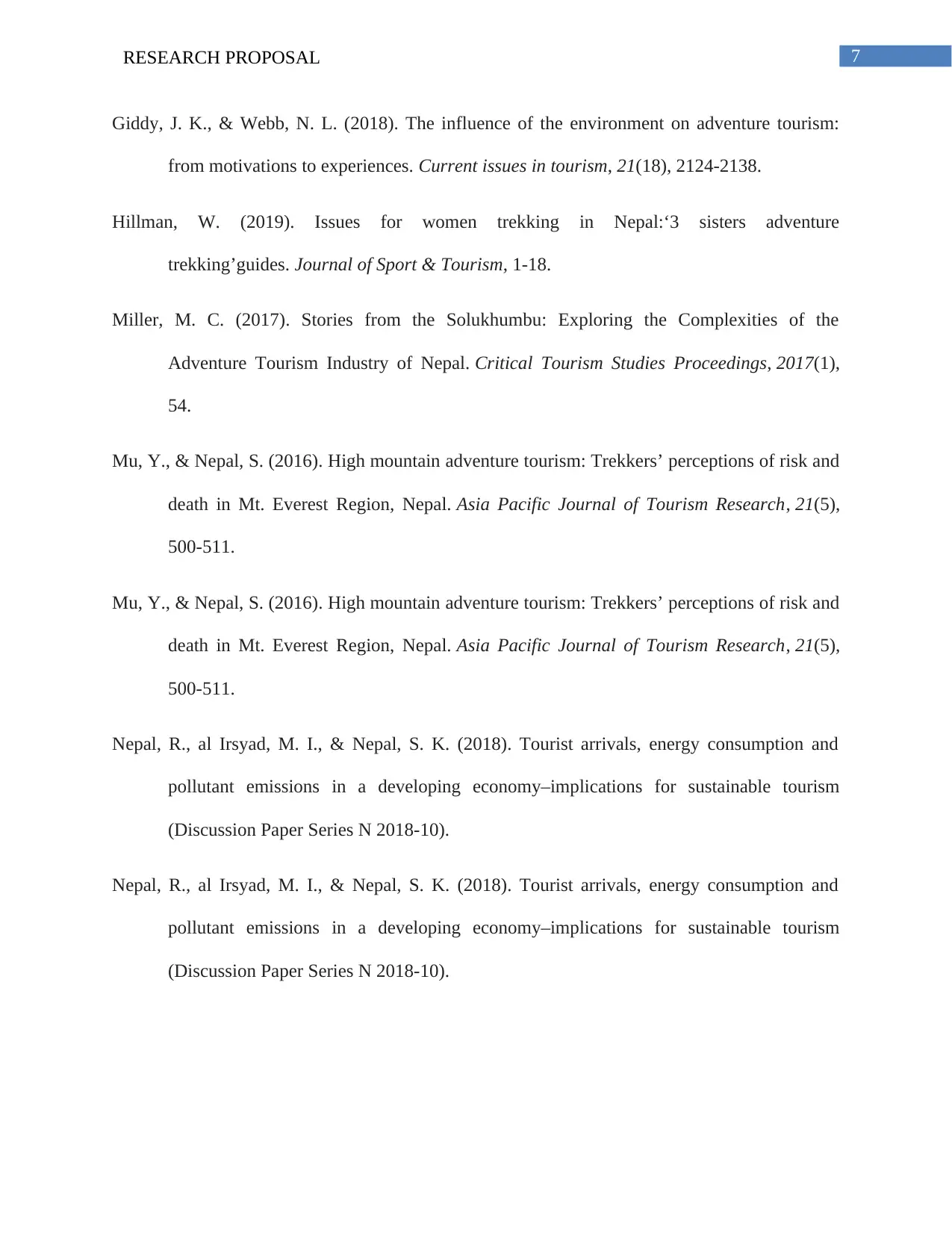
7RESEARCH PROPOSAL
Giddy, J. K., & Webb, N. L. (2018). The influence of the environment on adventure tourism:
from motivations to experiences. Current issues in tourism, 21(18), 2124-2138.
Hillman, W. (2019). Issues for women trekking in Nepal:‘3 sisters adventure
trekking’guides. Journal of Sport & Tourism, 1-18.
Miller, M. C. (2017). Stories from the Solukhumbu: Exploring the Complexities of the
Adventure Tourism Industry of Nepal. Critical Tourism Studies Proceedings, 2017(1),
54.
Mu, Y., & Nepal, S. (2016). High mountain adventure tourism: Trekkers’ perceptions of risk and
death in Mt. Everest Region, Nepal. Asia Pacific Journal of Tourism Research, 21(5),
500-511.
Mu, Y., & Nepal, S. (2016). High mountain adventure tourism: Trekkers’ perceptions of risk and
death in Mt. Everest Region, Nepal. Asia Pacific Journal of Tourism Research, 21(5),
500-511.
Nepal, R., al Irsyad, M. I., & Nepal, S. K. (2018). Tourist arrivals, energy consumption and
pollutant emissions in a developing economy–implications for sustainable tourism
(Discussion Paper Series N 2018-10).
Nepal, R., al Irsyad, M. I., & Nepal, S. K. (2018). Tourist arrivals, energy consumption and
pollutant emissions in a developing economy–implications for sustainable tourism
(Discussion Paper Series N 2018-10).
Giddy, J. K., & Webb, N. L. (2018). The influence of the environment on adventure tourism:
from motivations to experiences. Current issues in tourism, 21(18), 2124-2138.
Hillman, W. (2019). Issues for women trekking in Nepal:‘3 sisters adventure
trekking’guides. Journal of Sport & Tourism, 1-18.
Miller, M. C. (2017). Stories from the Solukhumbu: Exploring the Complexities of the
Adventure Tourism Industry of Nepal. Critical Tourism Studies Proceedings, 2017(1),
54.
Mu, Y., & Nepal, S. (2016). High mountain adventure tourism: Trekkers’ perceptions of risk and
death in Mt. Everest Region, Nepal. Asia Pacific Journal of Tourism Research, 21(5),
500-511.
Mu, Y., & Nepal, S. (2016). High mountain adventure tourism: Trekkers’ perceptions of risk and
death in Mt. Everest Region, Nepal. Asia Pacific Journal of Tourism Research, 21(5),
500-511.
Nepal, R., al Irsyad, M. I., & Nepal, S. K. (2018). Tourist arrivals, energy consumption and
pollutant emissions in a developing economy–implications for sustainable tourism
(Discussion Paper Series N 2018-10).
Nepal, R., al Irsyad, M. I., & Nepal, S. K. (2018). Tourist arrivals, energy consumption and
pollutant emissions in a developing economy–implications for sustainable tourism
(Discussion Paper Series N 2018-10).
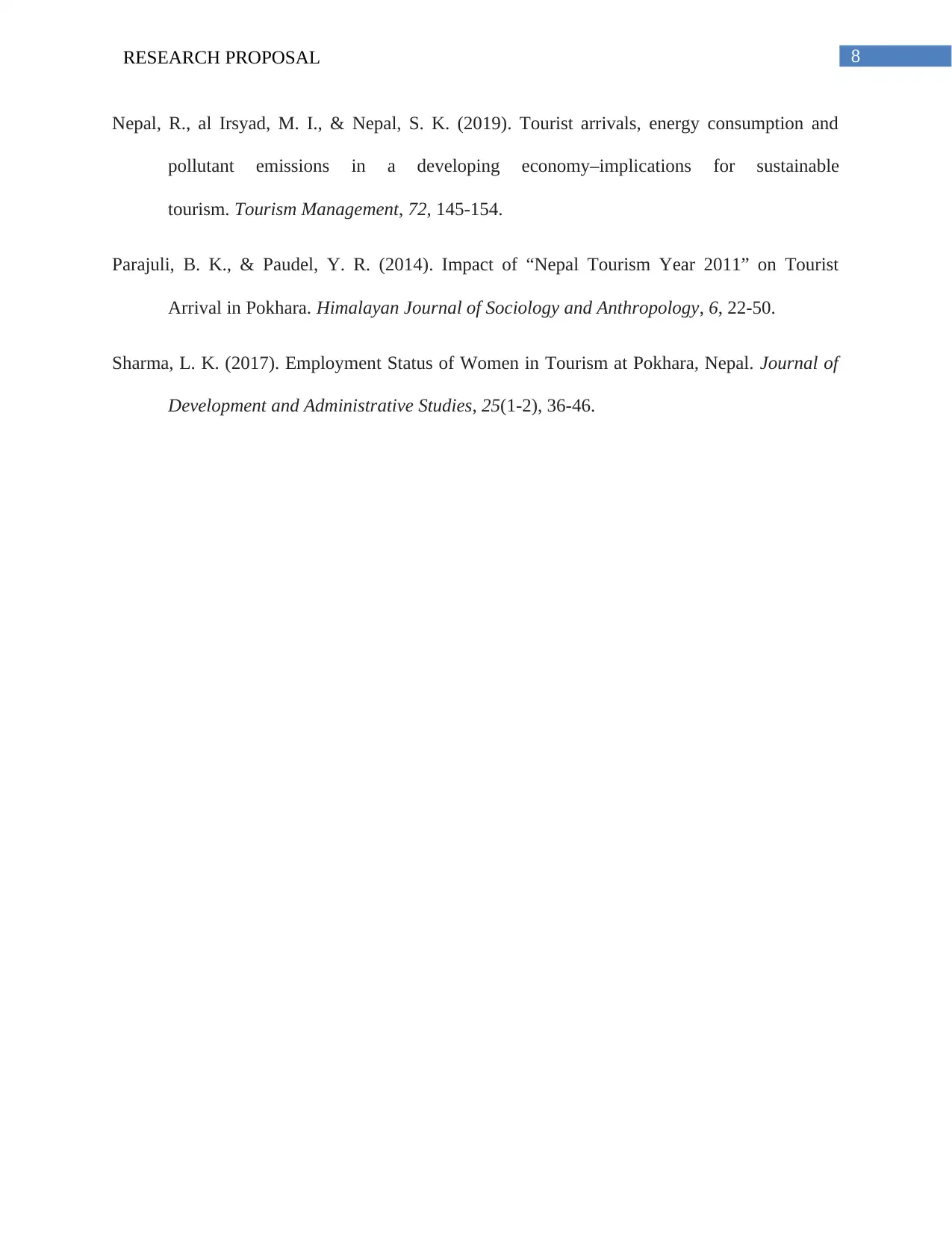
8RESEARCH PROPOSAL
Nepal, R., al Irsyad, M. I., & Nepal, S. K. (2019). Tourist arrivals, energy consumption and
pollutant emissions in a developing economy–implications for sustainable
tourism. Tourism Management, 72, 145-154.
Parajuli, B. K., & Paudel, Y. R. (2014). Impact of “Nepal Tourism Year 2011” on Tourist
Arrival in Pokhara. Himalayan Journal of Sociology and Anthropology, 6, 22-50.
Sharma, L. K. (2017). Employment Status of Women in Tourism at Pokhara, Nepal. Journal of
Development and Administrative Studies, 25(1-2), 36-46.
Nepal, R., al Irsyad, M. I., & Nepal, S. K. (2019). Tourist arrivals, energy consumption and
pollutant emissions in a developing economy–implications for sustainable
tourism. Tourism Management, 72, 145-154.
Parajuli, B. K., & Paudel, Y. R. (2014). Impact of “Nepal Tourism Year 2011” on Tourist
Arrival in Pokhara. Himalayan Journal of Sociology and Anthropology, 6, 22-50.
Sharma, L. K. (2017). Employment Status of Women in Tourism at Pokhara, Nepal. Journal of
Development and Administrative Studies, 25(1-2), 36-46.
⊘ This is a preview!⊘
Do you want full access?
Subscribe today to unlock all pages.

Trusted by 1+ million students worldwide
1 out of 9
Related Documents
Your All-in-One AI-Powered Toolkit for Academic Success.
+13062052269
info@desklib.com
Available 24*7 on WhatsApp / Email
![[object Object]](/_next/static/media/star-bottom.7253800d.svg)
Unlock your academic potential
Copyright © 2020–2025 A2Z Services. All Rights Reserved. Developed and managed by ZUCOL.



